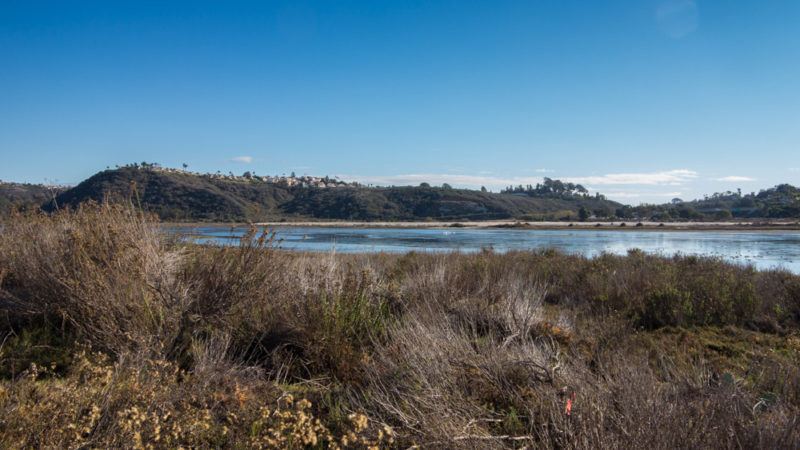
Blog |
Losing childhood places in an age of regulatory rollback
by Kyla Wilson
I was raised on the sandstone hills above San Elijo Lagoon, just a couple miles south of Batiquitos Lagoon. As a child, these inlets where river runoff meet ocean were sanctuaries from suburbia. Each time we visited, I hoped to spot a Great Blue Heron, the elusive grey guardian of the marshes. In school, we learned about the key native species of estuaries, how pickle weed turns red from the salt water, and how to tell the difference between a great egret and a snowy egret. I still take pride in knowing that of these two white water birds, the great egret has a yellow beak and black feet, while the snowy egret has the reverse. The lagoon offered endlessly fascinating wilderness. Unfortunately, the President Donald Trump administration’s decision to reduce Clean Water Act rules now threatens these beautiful and critically important lands.
When I travel home these days, I see how constrained the estuaries are—coastal sage scrub, scarred by highways, butts up directly against residential fences. Historically, wetlands have been drained and filled and paved over. The United States has lost over 70 percent of its natural wetlands. These places recharge groundwater, improve water quality, and buffer cities from floods and storms. The more we reduce and pollute them, the more concerned I become about the future of water resource regulations and public health. Our wetlands are shrinking, and they constantly face losing battles against development.
In 1963, the International Waterfowl and Wetlands Research Bureau initiated negotiations on an international wetlands protection agreement specifically for their value as migratory hotspots to birds. This culminated in the 1971 Ramsar Convention for the conservation and wise use of broadly defined wetlands of which 169 countries have now signed. As much as I love the diversity of bird species and protection of waterfowl, the protection of wetlands has also been recognized internationally for its economic and public health benefits. The 1997 Millennium Ecosystem Assessment estimated the value of global wetlands at $15 trillion. In the U.S. alone, coastal wetlands save $23.2 billion in hurricane protection each year. In 1997, New York decided to protect and mitigate harmful development in the Catskills Mountains watershed that provides the city’s drinking water. It saved $3 to 8 billion by avoiding the alternative of a water treatment plant. Even though these economic benefits are widely accepted in the international and scientific community, many still seem to believe conservation efforts hinder economic growth.
The Trump administration is currently working to roll back rules to the US Clean Water Act like the Stream Protection Rule and Clean Water Rule in the name of job creation, hoping to revive the coal industry and protect farmers. These businesses are the industrial roots of America, but at what cost to public health and natural resources do we make such exceptions?
According to the Environmental Protection Agency, 60 percent of streams in the U.S. are seasonal. Seasonal waterways are generally not considered navigable and therefore not as clearly managed by the US Clean Water Act. The Clean Water Rule was drafted in 2015 with the intent of clarifying management of seasonal streams and wetland areas. The rule is still under review, but it has major conservation potential for coastal wetland areas that are threatened by development, sea level rise and upstream pollution. There needs to be compromise between development and preservation, but we cannot hope to maintain ecosystem benefits if we continue to diminish environmental regulatory space. Much of the rhetoric used against the Clean Water Rule demonizes it as an affront to farmers.
Farmers have a right to be concerned about new water legislation, considering their high reliance on water resources and the impact of pesticide and fertilizer pollution on aquatic habitats. But the Clean Water Rule doesn’t necessarily negatively impact agricultural water management. In fact, it could relieve regulatory confusion and make management and permitting more straightforward. The rule is the result of the Supreme Court’s ruling on seasonal waterways in Rapanos v. U.S. The refinement of laws into enforceable regulation through litigation is a natural legislative progression. Ambiguity only leaves space for egregious industrial exceptions. Similarly, the Stream Protection Rule prevents the dumping of industrial waste in to local waterways.
So what does the Trump administration hope to achieve by reducing enforceable water management regulation and conservation? How much will it cost the US to restore these lands in the future? If the goal is to protect American farmers and coal workers, it is hard to imagine that regulatory ambiguity and loss of valuable wetlands will result in greater security. This lack of coherency and preservation spells future natural disaster, economic loss and continued habitat destruction.
Main photo: Batiquitos Lagoon, by Jim Buss.
